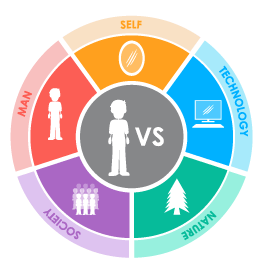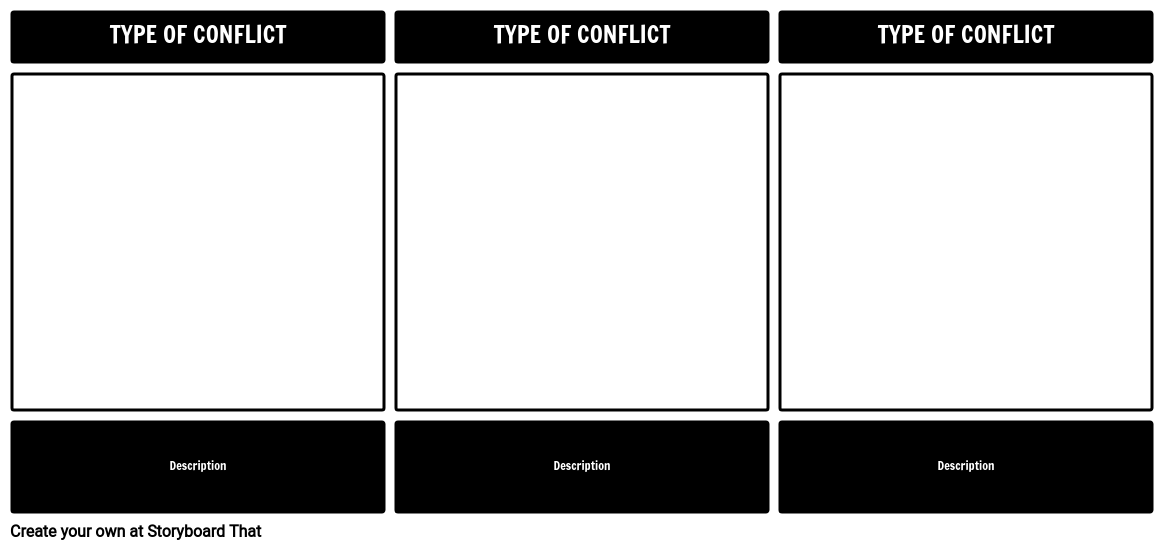Activity Overview
Literary conflicts are often taught during ELA units. Building on prior knowledge to achieve mastery level with our students is important. An excellent way to focus on the various types of literary conflict is through storyboarding. Having students choose an example of each literary conflict and depict it using the Storyboard Creator is a great way to reinforce your lesson!
In Hamlet, much of the conflict stems from the information the ghost gives Hamlet, which ultimately leads to his death. In each of the plays acts, Hamlet's need for revenge causes misfortune and death.
Having students create storyboards that show the cause and effect of different types of conflicts reinforce and develop literary analysis strengths.
Examples of Literary Conflict in Hamlet
MAN vs. MAN: Laertes vs. Hamlet
The men argue, and eventually fight over the deaths of Polonius and Ophelia.
MAN vs. SOCIETY: Hamlet vs. Court
Hamlet struggles with the Danish court. Convention has placed Claudius on his brother's throne, and allowed him to marry Gertrude, both of which upset Hamlet.
MAN vs. SELF: Hamlet vs. Himself
“To be or not to be, that is the question!”
Template and Class Instructions
(These instructions are completely customizable. After clicking "Copy Activity", update the instructions on the Edit Tab of the assignment.)
Student Instructions
Create a storyboard that shows at least three forms of literary conflict in Hamlet.
- Identify conflicts in Hamlet.
- Categorize each conflict as Character vs. Character, Character vs. Self, Character vs. Society, Character vs. Nature, or Character vs. Technology.
- Illustrate conflicts in the cells, using characters from the story.
- Write a short description of the conflict below the cell.
Lesson Plan Reference
Rubric
(You can also create your own on Quick Rubric.)
| Proficient | Emerging | Beginning | Try Again | |
|---|---|---|---|---|
| Conflict Identification | Student identifies correct major conflicts and uses strong, clear textual evidence to support choice. | Student identifies correct major conflict and uses few or unclear details to support their choice. | Student identifies incorrect major conflict, and uses some details from the text to support their choice. | Student does not attempt to identify major conflict or identifies incorrect major conflict with no explanation. |
| Understanding Outcome | Student clearly shows the outcome of the conflict and its effects on the protagonist with evidence from the text. | Student shows the outcome of the conflict and its effect on the protagonist, but some evidence is unclear. | Student shows the outcome of the conflict, but does not examine its effect on the protagonist and uses some vague textual evidence. | Student does not clearly show the outcome of the conflict or use textual evidence. |
| Character | Storyboard includes all required characters and clearly names them. Goes above and beyond by adding additional details. | Storyboard includes all required characters and clearly names them. | Storyboard includes protagonist and antagonist but leaves out other required characters. | Storyboard does not include the names of required characters. |
| Storyboard | Student clearly shows effort to convey the setting the scene of the book | Student attempts to convey setting and scene of the book, but lacks some clarity. | Student does not clearly convey the setting and scene. | Student makes little or no attempt to convey the setting or scene. |
| Spelling and Grammar | Student uses exemplary spelling and grammar. There are no errors. | Student makes a minor error in spelling and grammar. | Student makes several minor errors in spelling and grammar. | Student makes many errors in spelling and grammar; little attempt at spellchecking. |
How To Use Different Types of Literary Conflicts in Writing
Introduce and Choose Conflicts
Introduce the types of literary conflicts and ask the students to choose one or more conflict types that go along with the topics and characters in their writing. Think about how each category might increase tension and advance the story as a whole.
Introduce Key Characters and Ambitions
Ask the students to describe their key characters and explain each one's unique struggles, aspirations, or ambitions. Make sure the reader can understand and relate to their motivations.
Integrate Selected Conflict Types Into the Plot
Weave conflict into the story. Create scenarios or barriers that directly contradict the objectives and convictions of your characters.
Highlight Conflict Interactions
Develop scenes that highlight the exchanges that come from conflicts to illustrate conflict interactions. In any conflict, whether it involves characters arguing, making decisions, or overcoming obstacles, it's important to emphasize the emotional aspect.
Frequently Asked Questions About Identifying Literary Conflict in Hamlet
How Are These Conflicts Used to Develop Hamlet's Character?
Hamlet's character development is driven by the difficulties he encounters. His personal conflicts inspire reflection, his conflicts with Claudius and others demonstrate his tenacity, and his run-ins with the paranormal test his religious convictions. Overall, all of the literary conflicts used in play an important role in the story as well as Hamlet’s personal growth.
What Ways Do the Conflicts Get Addressed in the Play?
The way the conflicts are resolved differs. While Hamlet's death settles his psychological issues, the last act's encounter between Hamlet and Claudius concludes the man-versus-man conflict. The conflicts between man and fate and society are open to interpretation.
How Does Literary Conflict Identification Improve Interpretation?
Conflicts can be better understood by highlighting how complex personalities and concepts are. It enables readers to comprehend the characters' reasons for their actions as well as how these conflicts add to the play's overall meaning.
More Storyboard That Activities
Tragedy of Hamlet, Prince of Denmark, The
This Activity is Part of Many Teacher Guides
© 2024 - Clever Prototypes, LLC - All rights reserved.
StoryboardThat is a trademark of Clever Prototypes, LLC, and Registered in U.S. Patent and Trademark Office















